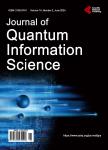Interplay of Quantum Stochastic and Dynamical Maps to Discern Markovian and Non-Markovian Transitions
Interplay of Quantum Stochastic and Dynamical Maps to Discern Markovian and Non-Markovian Transitions作者机构:Department of Physics Bangalore University Bangalore India Inspire Institute Inc. Alexandria Virginia USA
出 版 物:《Journal of Quantum Information Science》 (量子信息科学期刊(英文))
年 卷 期:2012年第2卷第3期
页 面:47-54页
学科分类:07[理学] 0701[理学-数学] 070101[理学-基础数学]
主 题:Open System Dynamics Non Markovianity Not Completely Positive Maps
摘 要:It is known that the dynamical evolution of a system, from an initial tensor product state of system and environment, to any two later times, t1, t2 (t2 t1), are both completely positive (CP) but in the intermediate times between t1 and t2 it need not be CP. This reveals the key to the Markov (if CP) and non Markov (if it is not CP) avataras of the intermediate dynamics. This is brought out here in terms of the quantum stochastic map A and the associated dynamical map B—without resorting to master equation approaches. We investigate these features with four examples which have entirely different physical origins: 1) A two qubit Werner state map with time dependent noise parameter;2) Phenomenological model of a recent optical experiment (Nature Physics, 7, 931 (2011)) on the open system evolution of photon polarization;3) Hamiltonian dynamics of a qubit coupled to a bath of N qubits;4) Two qubit unitary dynamics of Jordan et al. (Phys. Rev. A 70, 052110 (2004) with initial product states of qubits. In all these models, it is shown that the positivity/negativity of the eigenvalues of intermediate time dynamical B map determines the Markov/non-Markov nature of the dynamics.



